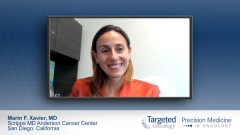
DLBCL: Approaches for Monitoring Frontline Treatment Response
Debates regarding the proper timing for repeat scans, interval CT testing, and surveillance imaging on patients with diffuse large B-cell lymphoma following frontline therapy.
Episodes in this series

Marin F. Xavier, MD: John, we talked a lot about the landscape and then standard frontline therapy. We both refuted the maintenance setting. Then we touched on monitoring response to therapy, we talked about interim PET [positron emission tomography] scans. How do you treat? When do you repeat scans? What scan do you do and how do you use that to adapt your therapy?
John M. Burke, MD: For patients of mine who are going to get 6 cycles of R-CHOP [rituximab, cyclophosphamide, hydroxydaunorubicin hydrochloride, vincristine, prednisone], which is most patients, I’ve taken to doing an interim CT scan. I’ve had trouble, so I’ve taken to doing an interim CT scan, usually after 3. A number of trials will do that and the PET-CT after 3 or 4 cycles. In my practice, insurance companies haven’t been fond of the interim PET-CT scan, so I’ve stopped fighting that battle. It’s no longer on NCCN [National Comprehensive Cancer Network] Guidelines. I do an end-of-treatment PET, and that’s typically 6 to 8 weeks after the last cycle. I check an interim CT scan about halfway through, after 3. Usually it’s obvious if they’re getting better, but I guess it’s to make me feel better that they’re not having overt new spots that I’m not aware of. That’s my imaging strategy.
Marin F. Xavier, MD: That’s interesting. I was wondering because we both practice in lean environments. I’m in California with managed care, and you’re in a large group with your own guidelines. I agree that how I treat is getting outdated with the interim PET. The end-of-treatment PET is also extremely useful for what we mentioned for residual disease, especially in areas of bulk. Yes, that interval CT and when do you do it? Every oncologist has their own style. My partner does CTs after 2, the other 1 does it in the middle. It’s interesting to know that that battle you stopped fighting, which is appropriate. As long as somebody doesn’t have new lesions and clinical progression, that’s a good strategy.
John M. Burke, MD: The only time I’m using the interim PET, as I said, is for early stage ones where I do it after 3, with the idea that I’m going to stop after 4 if they’re negative after 3.
Marin F. Xavier, MD: I love that. Your insurance companies must love you. You practice very evidence based. I would say it’s value-based oncology. It’s awesome.
John M. Burke, MD: There’s a lot of pressure. It’s an interesting point. You talk to community doctors, and a lot of people talk the same way. You can hear in their voices, in their approaches, the evidence that there’s pressure on us all to save costs and practice value-based medicine. It’s true.
Marin F. Xavier, MD: The 1 area where I may be a big spender in the front end, but I’m very lean on my surveillance imaging. I don’t know: do you surveil patients after they’re in remission?
John M. Burke, MD: I consider myself very lean. I individualize and bring the patient into that discussion quite a bit about pros and cons and the fact that we don’t know that there’s any survival advantage. There are downsides to it. It exposes them to radiation, it exposes them to cost, and even when you do them, a lot of patients find their own relapses between the scans. Despite that, I have some patients who prefer to do them, and that’s fine. Guidelines allow us to do those every 6 months or so for a couple of years. For the majority of patients, I probably don’t do it. How about you?
Marin F. Xavier, MD: That was my research when I was a fellow.
John M. Burke, MD: Awesome. Tell me what to do.
Marin F. Xavier, MD: It’s exactly right, the reason why it’s no longer considered a recommendation to do surveillance at every 3 months, like we used to do 20 years ago, is because it doesn’t improve outcomes. I tell my patients that I have a very low threshold to scan them. If they have a weird pain of any sort or gas or just have a weird feeling and they need reassurance, I’m very flexible. Apart from that, I tell them I don’t look for it if you’re feeling well and your blood work—I might do it if the LDH [lactate dehydrogenase] pops up really high. I do labs, and if there’s something abnormal that suggests something, I do them. But not just surveillance in the absence of any clinical or patient concern.
John M. Burke, MD: Do some of your patients drive you and say, “I don’t feel comfortable not doing scans. Can we do 1 every once in a while?”
Marin F. Xavier, MD: Surprisingly not. I do have a guy in his 40s who gets nervous every year. I don’t fight with him. I say, “If it’s covered, we’ll do it.” It’s the milestones, but after 2 or 3 years for sure. This is a disease in which the majority of patients will relapse within the first 2 or 3 years. After that I have a much higher threshold to do imaging.
John M. Burke, MD: An exception to that comment is those early stage patients. One interesting thing I’ve learned in recent years is long-term follow-up with some of those early stage studies indicating that for those stage I/II patients, it’s a different disease. It can relapse late, even 10 to 15 years later if you looked at those PFS [progression-free survival] curves. That’s 1 thing. I encourage those early stage patients to keep coming in once a year. I don’t scan them, but just keep coming in once a year after 5 years for your long-term check-ins.
Marin F. Xavier, MD: I had a 6-year relapse in 2 patients. They were the leg-type of diffuse large B-cell lymphoma, so it was kind of limited initially. There’s another situation that’s not the topic, but primary mediastinal large cell lymphoma. It’s interesting trying to avoid radiotherapy for those guys. I have a 19-cm mass, and there’s residual [disease]. You’re looking at the Deauville scores and trying to give them some time to simmer down on their scans and avoid doing radiation if there’s some residual PET activity. I’ve started paying a lot more attention to those scores in patients who could safely avoid radiation after systemic therapy. That’s for my patients with primary mediastinal [lymphoma] because they have massive disease sometimes.
Transcript edited for clarity.








































